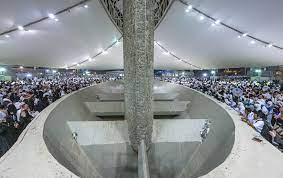MAKKAH (AFP): Hundreds of thousands of robed faithful hurled pebbles in the “stoning of the devil” ritual on Wednesday as the biggest Hajj pilgrimage since the start of the pandemic draws to a close in Saudi Arabia.
From dawn in Mina, vast crowds of Muslim pilgrims began pelting three concrete monoliths representing Satan, and heading to Makkah for a final “tawaf” — walking in circles around the holy Kaaba.
More than 1.8 million people are taking part in the first unrestricted Hajj since COVID struck in 2020. About 2.5 million, the most on record, joined the pilgrimage in pre-pandemic 2019.
As well as crowds at every turn, the visitors have had to contend with ferocious temperatures at the Hajj, which currently coincides with the Saudi summer.
Temperatures peaked at 48 degrees Celsius on Tuesday, when the pilgrims prayed for hours at Mount Arafat, and were expected to hit 47 degrees on Wednesday in Mina.
As helicopters buzzed overhead, pilgrims flooded the streets around Mina. In Makkah, the Grand Mosque was packed from the early morning with pilgrims, who loudly congratulated each other on completing the rituals.
This year’s attendance figure, announced by Saudi officials on Tuesday, falls well short of their predictions of beating the 2019 record, possibly because of the heat or the cost, at around $5,000 per person just to attend.
The overwhelming majority of the 1.8 million pilgrims — more than 1.6 million — are foreigners, coming from about 160 countries.
Saudi Arabia’s King Salman issued a message wishing “wellbeing and prosperity on our country, on Muslims and the world” and announced he would pay for sacrificial animals for nearly 5,000 of the poorest pilgrims.
Wednesday’s devil-stoning marks the start of the three-day Eid ul Adha holiday, celebrated by Muslims by buying and slaughtering livestock to commemorate Prophet Ibrahim (AS) willingness to sacrifice his son.
In recent years the Hajj, which follows the lunar calendar, has fallen in the Saudi summer, at a time when global warming is making the desert climate even hotter.
Experts have warned that temperatures of 50 degrees Celsius could become an annual occurrence in Saudi Arabia by the end of the century.







